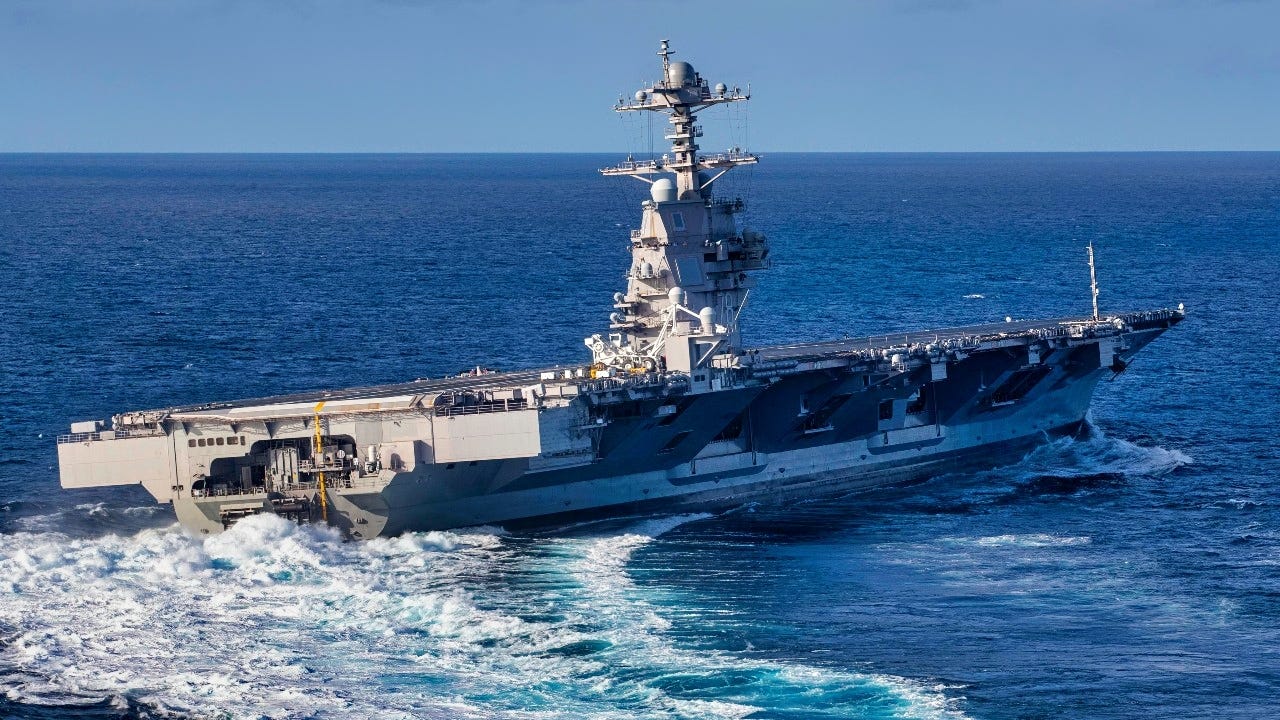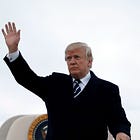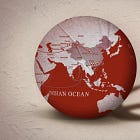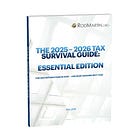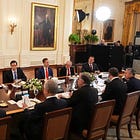Control the Hemisphere, Contain China: Inside America’s Two-Front Strategy
Donald Trump's reinvigorated Monroe Doctrine isn't a distraction from his efforts to contain China: it's their foundation.
This essay is free, but with Premium Membership you get MORE. Join today.
NOTE: This article is a FREE taste of the sort of analysis available with a PREMIUM Membership. If you want a much deeper look at the Venezuela buildup, I wrote a Deep Dive on exactly that just a couple of weeks ago. We’ve also covered the legal case for using the Alien Enemies Act against Venezuelan gangs, whether the Trump Administration may lawfully blow up Venezuelan drug boats, and of course, every aspect of our evolving China relationship, analysis Fox Business calls “absolutely phenomenal.”
Enjoy this enlightening essay by Andrew Latham. And then sign up for your Premium or Inner Circle Membership (you also get free copies of all my books, plus our NEW 2025 Tax Survival Guide - Advanced Edition). — RDM
by Andrew Latham
November 18, 2025
The USS Gerald R. Ford’s gray silhouette cutting across the Caribbean horizon marks a decisive shift in American statecraft: U.S. foreign policy is focusing intensely on the Western Hemisphere and the Indo-Pacific.
From the Ford’s slow approach to Venezuelan waters to escalating trade tensions with Canada and early signs of a harder U.S. line toward Mexico and migration, Washington’s attention is once again concentrated on the regions most vital to its security and power.
This is no tactical coincidence. It reflects a deliberate recalibration under President Trump, binding hemispheric defense to the broader logic of great-power competition. The United States is refortifying its neighborhood not as a retreat from global leadership, but as the bedrock from which it intends to sustain it.
The official story, of course, is that the Ford’s presence off Venezuela is part of an anti-drug, anti-cartel mission. The larger calculus, however, is clear enough: it is about demonstrating and regaining U.S. maritime and aerial supremacy in its southern approaches, and about showing that no outside power — China, Russia or Iran — will be allowed to establish a permanent presence in the Americas.
For decades, the Caribbean had been considered a quiet backwater. Now it is a proving ground for the reinvigorated use of sea power in the defense of the hemisphere. By deploying a supercarrier, Washington has shown that the Caribbean is once more a forward battleground in the projection of American deterrence.
It is not a return to gunboat diplomacy. It is an acknowledgment that great-power competition now extends to every maritime approach in which the adversary might test for advantage. The strategic renaissance of the Caribbean is thus an updated Monroe Doctrine, stripped of its 19th-century paternalism. It is based on the belief that the defense of the American homeland starts well beyond the shoreline.
Economic Fronts: Canada and Mexico in the Crosshairs
While the Navy reasserts control of the southern seas, the continental dimensions of hemispheric power are being defined through trade and migration policy. The new tariff standoff with Canada, long America’s most dependable ally, shows that even the friendliest partners are being affected by Washington’s strategic nationalism.
Trump’s message is simple: economic sovereignty and defense are paramount, and no ally should expect preferential treatment if its industries undermine American competitiveness or security.
At the same time, there are strong indications of a tougher U.S. stance toward Mexico. Proposed enforcement mechanisms at the border, the tightening of supply-chain rules, and a likely review of migration protocols suggest that economic integration will increasingly serve strategic ends. Washington appears to see Mexico not as a buffer but as a pressure point — an area where trade, labor, and security converge into one system.
Together, these moves reveal the architecture of what might be called the “continental fortress”: a North America more economically integrated under U.S. dominance, but also more tightly managed in the name of security and competition.
Trump’s Grand Strategic Vision: Securing the Hemisphere, Blunting China
Trump’s grand strategic vision is not isolationist, nor is it the liberal internationalism of his predecessors. It is hemispheric and selective — focused on securing the Western Hemisphere while simultaneously blunting China’s expanding bid for power and influence across the Indo-Pacific. The logic is almost classical: before projecting power outward, consolidate strength within one’s sphere of influence.
In this conception, the Western Hemisphere is the indispensable core from which the United States can compete effectively with China abroad. This explains the parallel emphasis on hemispheric defense and Indo-Pacific containment.
The administration’s new naval posture in the Caribbean, its scrutiny of Chinese port investments in Panama and the Caribbean, and its quiet support for Latin American governments seeking to push back against Beijing’s influence all serve the same purpose — to deny China strategic depth in America’s neighborhood while reinforcing U.S. freedom of action across the Pacific.
What emerges is a two-front strategy defined not by expansionism but by disciplined geography: control the hemisphere, deny the adversary’s periphery, and maintain maritime advantage in both oceans.
This also helps explain the reorientation of American diplomacy toward transactional realism. Trump has little interest in multilateral moralizing or global crusades. He views power through the lens of geography and leverage. By focusing on the hemisphere and the Indo-Pacific, he is redefining what it means for America to be a global power in the 21st century: not omnipresent, but unassailable in its core regions and unyielding where vital interests are at stake.
Redefining Hemispheric Defense
The emerging doctrine of hemispheric defense fuses military presence, economic leverage, and border control into a single system of deterrence. Migration flows, energy corridors, data networks, and supply chains are no longer treated as separate policy arenas — they are integrated components of national defense.
This is the new realism of power: defending the homeland means managing the arteries through which people, goods, and influence flow. The Western Hemisphere is being recast as a platform for global competition, a staging ground for future economic and technological contests as much as for military ones.
This grand strategy is a return to very deep-rooted traditions in American statecraft, updated to suit the current era. Just as the architects of containment during the Cold War saw Europe, the Middle East, and Asia as the epicenters of the struggle, Trump’s strategists see the hemisphere as the indispensable homeland of American power in an era of global contest.
The same instincts that once drove continental expansion now drive the consolidation of continental defense. The United States is again acting like a great power that understands its geography: surrounded by oceans, connected to allies by trade and migration, and vulnerable where those flows are uncontrolled.
There are obvious risks in this revival of hemispheric strategy. But these dangers, in Trump’s calculus, are manageable compared to the alternative — ceding strategic ground in the Americas while overextending elsewhere. His administration sees the hemisphere as the one theater where America can still dictate terms. Everything beyond it, from the South China Sea to Eastern Europe, must be approached from that foundation.
When the World Comes Home
The Ford’s steady advance toward Venezuelan waters captures the essence of America’s new grand strategy: to defend the hemisphere, contain China, and root great-power competition in geographic reality. The long-standing American habit of trying to shape events on every continent has been refocused — not as a retreat, but as a consolidation of power providing far greater flexibility and reach.
The Western Hemisphere is no longer a neglected periphery; it has become the front yard of great-power politics.
Whether this rebalancing endures will depend on Washington’s ability to wield power with restraint, transforming proximity into stability rather than crisis.
One thing, however, is clear: the era of the open-ended liberal empire has ended. A new age of hemispheric power has begun, and the world will now have to reckon with an America determined to defend its dominance from within its own, far more secure neighborhood.
— Andrew Latham is a professor of international relations and political theory at Macalester College in Saint Paul, MN. This essay originally appeared in National Security Journal.


